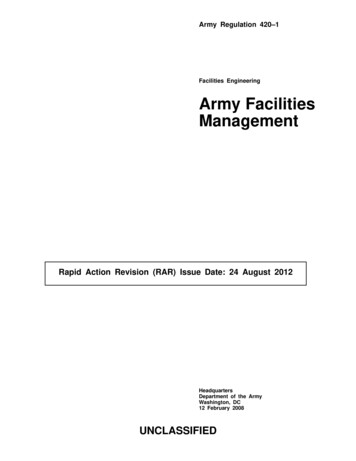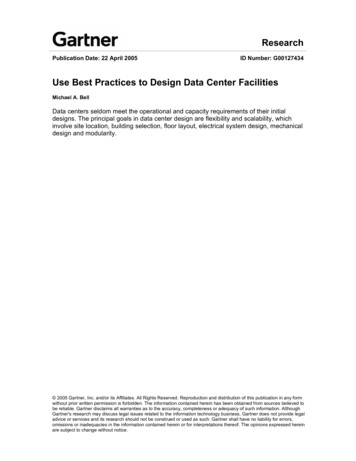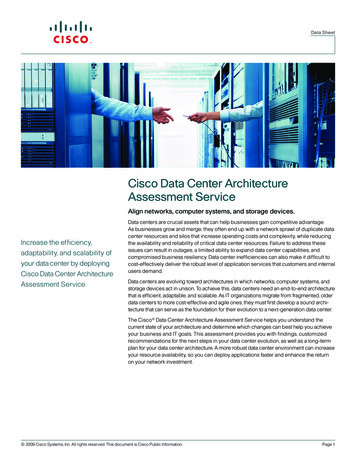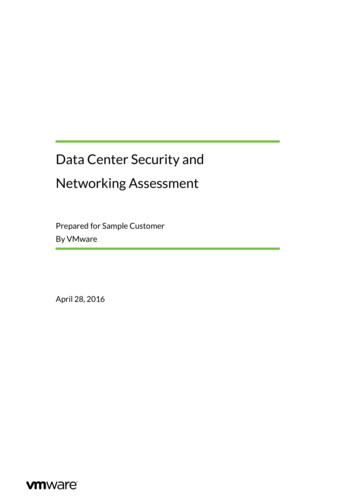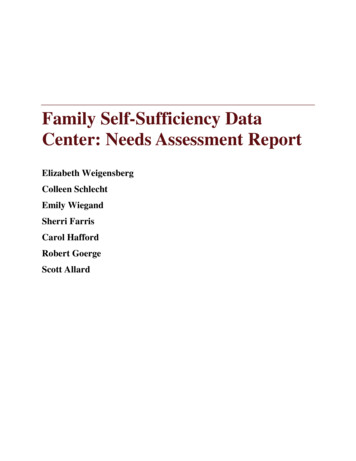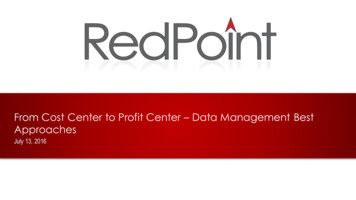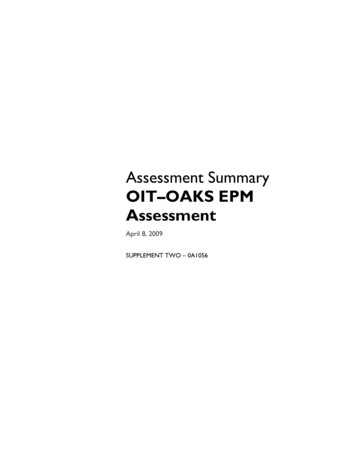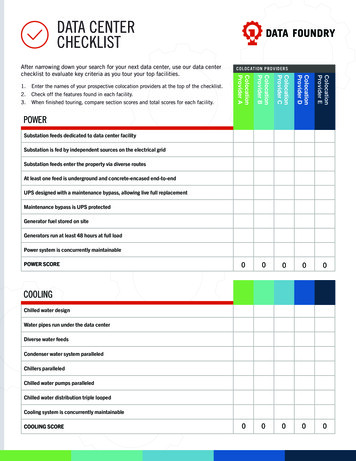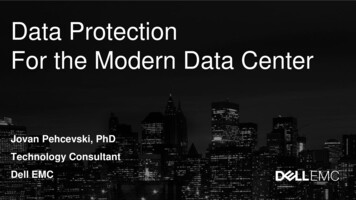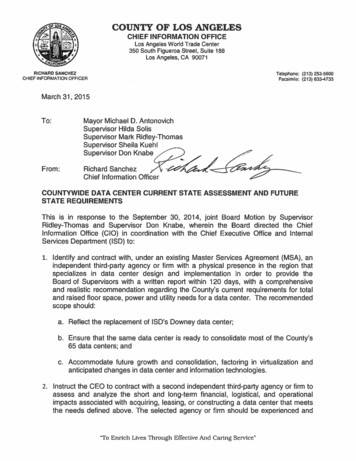
Transcription
Report on LA County’s Data Center StrategyCurrent State Assessment and Future State RequirementsMarch 30, 2015
Report on LA County’s Data Center StrategyCurrent State Assessment and Future State RequirementsInterim ReportTable of Contents1.0 Background . 21.11.2Board Motion . 2Data Gathering . 22.0 Current State Assessment . 32.1Inventory . 32.2Assessment . 33.0 Future State . 43.1Current Industry Trends and Data Center Best Practices . 43.2Future State Vision . 53.33.4Capacity Needs . 6Requirements . 74.0 Attachments . 84.14.2Attachment A – Current State Assessment . 8Attachment B – Data Center Inventory . 84.3Attachment C – ISD Assessment Report . 84.4Attachment D – Future State Vision and Capacity Model . 84.5Attachment E – Future State Requirements . 8March 30, 2015330025627 2015 Gartner, Inc. and/or its affiliates. All rights reserved.Page i
Report on LA County’s Data Center StrategyCurrent State Assessment and Future State Requirements1.0Background1.1Board MotionInterim ReportMarch 30, 2015 — Page 2In September of 2014, the Board of Supervisors adopted a multi-part motion, the first of whichwas to:“Instruct the Chief Information Officer (CIO), in consultation with the Director of the InternalServices Department (ISD) to identify and contract with, under an existing Master Agreement,an independent third party agency or firm with a physical presence in the region that specializesin data center design and implementation in order to provide the Board with a written reportwithin 120 days, with a comprehensive and realistic recommendation regarding the County’scurrent requirements for total and raised floor space, power and utility needs for a data center. Ifthere is not a vendor with the expertise under the existing Master Agreement, the ChiefInformation Officer and Director of Internal Services should return to the Board withrecommended vendors. The recommended scope should:a) Reflect the replacement of ISD’s Downey data center;b) Ensure that the same data center is ready to consolidate most of the County’s 64 datacenters; andc) Accommodate future growth and consolidation, factoring in virtualization and anticipatedchanges in data center and information technologies.The CIO contracted with Gartner to develop a currents state assessment and providerecommendations regarding the County’s data centers. This report provides the Current StateAssessment and the Future State Requirements for the consolidated data center. There willbe a second report by April 15, 2015 that will address the Governance Model and five-yearConsolidation Roadmap.1.2Data GatheringGartner, in collaboration with the Office of the CIO, identified forty-nine (49) operating datacenters in the County that needed to be assessed. This number is significantly less than thesixty four (64) data centers that was mentioned in the Board Motion due to the on-goingconsolidation effort that has already resulted in closure or decommissioning of several datacenters.Gartner then prepared application, facility, and IT asset data collection templates that weredistributed to all departments with active data center facilities and worked with the Office of theCIO to ensure that all departments provided all requested data.Gartner also visited and assessed the 49 active data centers (including the Local RecoveryCenter (LRC) in Orange County). Each site visit consisted of: A physical walk-though of the data center Collection and review of any supplemental documentation provided by the operatingstaff Meetings with departmental IT leadership, technical staff, network, and operationsengineering team membersMarch 30, 2015330025627 2015 Gartner, Inc. and/or its affiliates. All rights reserved.Page 2
Report on LA County’s Data Center StrategyCurrent State Assessment and Future State Requirements2.02.1Interim ReportMarch 30, 2015 — Page 3Current State AssessmentInventoryThrough its data collection efforts, Gartner determined the County’s current data centerinventory, power and space consumption. The main inventory numbers are: 430 mission critical applications (as identified by the departments). 67,000 square feet of space occupied by data centers. 7.49 megawatts of power provisioned and 2.37 megawatts of power consumed for ITequipment (32% of provisioned power is consumed). 1,142 racks of IT equipment, including servers, storage, network equipment, etc. 6,822 Operating System Instances (OSI), including 1,189 non-virtualized x86 servers,5,407 virtualized x86 servers, and 226 mainframe and midrange logical servers (IBM Zseries, IBM P-Series, AS-400, HP-UX, and Tandem platforms). 14,891 Terabytes of raw storage.The County’s primary data center at Downey has the highest percentage of each of theseinventories: 26% of occupied space 20% of provisioned and 26% of consumed power 22% of racks 27% of OSI (another 7% at LRC) 27% of raw storage (another 22% at LRC)The Department of Health Services (about 10%) and the Sheriff department (about 15%) alsoaccount for a large percentage of the County’s inventory.See Attachment B for a two (2) page Data Center summary inventory which lists the keyattributes (size, contents, etc.) of each active County data center.2.2AssessmentFor each department, Gartner provided a report with schematics of its data center(s), summaryof departmental inventory, data center reliability (based on an industry standard tier system,explained on page 23 of Attachment A) and observations. These reports were validated with theDepartments. As an example, the report for ISD’s Downey facility is provided as Attachment C.The departmental assessments were then used to summarize the key findings for the County asa whole. The primary findings where: The County has already made significant strides to consolidate their systems, reducingthe number of County data centers from 64 a few years ago to 49 today. This reductionis partially due to departments moving to ISD’s environment and partially due todepartment level consolidations. Despite these efforts, the County’s data centerenvironment is still largely decentralized with 24 departments still operating at least onedepartmental data center.March 30, 2015330025627 2015 Gartner, Inc. and/or its affiliates. All rights reserved.Page 3
Report on LA County’s Data Center StrategyCurrent State Assessment and Future State RequirementsInterim ReportMarch 30, 2015 — Page 4 The County’s virtualization efforts have led to significant decreases in data centercapacity needs as more servers can consume less physical space and power. As aresult, the County is currently under-utilizing its space, cooling, and power capacity, withmany data centers using less than 50% of the available capacity (the County average forutilization of provisioned DC power capacity is 32%, see above). ISD’s eCloud offering provides a solid foundation for building a consolidated, virtualized,and shared environment. This is especially due to a variety of self-service options, pricelevels and disaster recovery capabilities. ISD should continue cost reduction efforts tomake eCloud more attractive to departments. None of the data centers operated by the County can be considered a dedicated datacenter facility (a facility that is only used for data center purposes). The only dedicatedDC site is LRC, which is operated by Orange County. All other data centers are inmultiuse facilities (office spaces, communications centers, hospitals, etc.) and many arein repurposed or multiuse rooms (storage closets, break room, office space, etc.). Nearly all data centers lack best practice degree of reliability that is expected for hostingmission critical applications. Only one data center (DHS MLK) can be considered a TierIII data center (best practice reliability for mission critical applications). There are 11 TierII facilities and 37 Tier I facilities. Both Downey and LRC data centers meet some but notall the requirements of a Tier III data center, and are therefore considered Tier II datacenters. County Departments are focused on maintaining their current facilities and do not haveformal strategies for their data centers or adequate disaster recovery capabilities. DHShas made some significant recent investments in their data centers at LAC-USC andMLK, and the Sheriff department has made significant recent investments at their datacenter in the Sheriff Communications Center (SCC). Besides ISD’s LRC in OrangeCounty, none of the departments have hot site disaster recovery, which is best practicefor mission critical applications. All of the County’s data centers, including ISD’s disaster recovery site in Orange County,are subject to seismic risk. An earthquake could affect the County’s ability to maintaincurrent IT operations. Only four data centers are base isolated or have seismicallyreinforced buildings (Sheriff SCC, DHS LAC-USC, CEO Emergency Operations Center,and Fire).See Attachment A for a more detailed description of Gartner’s Assessment of each of theCounty’s Active Data Centers.3.03.1Future StateCurrent Industry Trends and Data Center Best PracticesWhile the current needs provide a critical input into the capacity needs for the future, keyindustry practices and trends are also important factors in determining the County’s Future Stateneeds. Gartner discussed and reviewed the following trends with CIO, CEO and ISDstakeholders for inclusion into the vision: Cost and risk pressures are forcing most organizations to fewer, higher quality datacenters. Reducing the number of data centers allows organizations to be more efficientin their use of space, power, cooling and staff and focuses security efforts to a fewlocations.March 30, 2015330025627 2015 Gartner, Inc. and/or its affiliates. All rights reserved.Page 4
Report on LA County’s Data Center StrategyCurrent State Assessment and Future State RequirementsInterim ReportMarch 30, 2015 — Page 5 The same cost and risk pressures are forcing organizations to rethink long held datacenter strategies around ownership, geographic distribution, co-location withpeople/corporate campuses, redundancy levels and use of cloud technologies as analternative to data centers. Most favor a few highly redundant (Tier III) data centers inseparate disaster strike zones. Many organizations are considering not owning their datacenter, but rather leasing space in a co-location facility and/or using cloud solutions. While the Public Sector lagged behind the Private Sector in adopting data centerconsolidation strategies, many government agencies have now implementedconsolidating policies. New York City and San Francisco City/County (the closestmunicipalities in terms of size) are both undergoing consolidation efforts. Additionally,almost all States have or are consolidating (due to its size and federated governmentstructure LA County is comparable to State governments). Virtualization technologies and the continued forward march of “Moore’s Law”(observation by the Founder of Intel that processing power for computers will doubleevery two years) will make future data centers “hotter and smaller”. New data centerswill be able to support exponentially increasing computation needs through linearincreases in power needs and little increase in space needs. As business processes become completely dependent on the IT systems, more robustdisaster recovery solutions will be required for most applications. Continuously available,active-active environments are becoming the norm as the business side becomes moreand more reliant on IT 24/7. Most public sector data center organizations have implemented private clouds, but willneed to turn these into hybrid cloud solutions to remain competitive. Hybrid cloudsolutions merge an organization’s privatecloud with public cloud offerings to reducecosts, provide additional agility and scalabilityand increase disaster recovery capabilities.3.2Future State VisionBased on the County’s current environment, marketpractices and trends, Gartner created the followingFuture Data Center Vision for the County: Active-Active Environment: LA Countyshould plan for two consolidated County datacenters capable of operating in an activeactive configuration with a maximum latencyof 10ms between data centers. Disaster Recovery: Primary and secondary data centers shall not be within the sameearthquake fault zone, unless mitigated by a third facility. Essential Facility Specifications: The Data Center building shell shall comply with theInternational Building Code (IBC) Essential Facility specifications. Tier III Reliability: To enhance availability and manage risk, consolidated data centersshall comply with TIA-942 Tier III specifications, and be able to pass formal certification ifso desired by the County.March 30, 2015330025627 2015 Gartner, Inc. and/or its affiliates. All rights reserved.Page 5
Report on LA County’s Data Center StrategyCurrent State Assessment and Future State RequirementsInterim ReportMarch 30, 2015 — Page 6 Operational Excellence: Facilities and IT operational maturity and excellence shall beassessed, monitored, and improved. Dedicated Facility: The data center building shall only house data center andassociated support services such as a Network Operations Center (NOC). Energy Efficient: Energy efficiency is of great importance. Every effort should be madeto design or select a facility for optimum energy efficiency. Total facility Power UsageEffectiveness (PUE) shall not exceed 1.4. The PUE is a metric used to determine theenergy efficiency of a data center. PUE is determined by dividing the amount of powerentering the data center by the power used to run the computer infrastructure within it. Modular Build: In order to satisfy future demand, while managing initial cost, datacenter power and cooling infrastructure shall be modular with ability to increase capacitywithout outage to any operating IT infrastructure.See pages 2-18 of Attachment D for a more detailed description of the County proposed DataCenter Future State vision.3.3Capacity NeedsGartner developed a capacity model to forecast the County’s needs over the next 10 years. Themodel incorporates the County’s current inventory, the expected technical environment of a newprimary facility, future growth estimates, estimated adoption of eCloud by consolidatingdepartments and contingency for space and power needs. Below are the key assumptionsapplied in the Capacity Model: Full consolidation of departmental systems in the new data center. Only systems at LRCand some departmental systems that are disaster recovery and would migrate into LRC(or another secondary site) will not migrate. The server and storage equipment purchases will align with ISD’s technology purchasesover the last two years. Servers will grow at a 10% rate year over year, with 20% growth in the first year and12% in the second to account for increases as departmental systems move to a newenvironment. 70% of departmental systems that are currently not on eCloud will consolidate toeCloud. The other 30% will be managed in an environment similar to their currentconfiguration in a co-location space. The model has a 30% contingency built in for both space and power to provide a marginof error.Sensitivity analysis was conducted on each of the assumptions. Based on the analysis, theCounty’s forecasted capacity is most sensitive to growth forecasts, departmental participationand technology purchases. Due to this analysis, some additional contingencies were added toboth space and power.The County’s new data center should eventually be able to accommodate a maximum of 2.1MWof power and 14,000 ft2 of space over the next 10 years. If not all departments participate, themaximum capacity may be less.More details regarding the results of the Data Center capacity modeling exercise and the inputsand assumptions which drove these results is contained in Attachment D.March 30, 2015330025627 2015 Gartner, Inc. and/or its affiliates. All rights reserved.Page 6
Report on LA County’s Data Center StrategyCurrent State Assessment and Future State Requirements3.4Interim ReportMarch 30, 2015 — Page 7RequirementsGartner developed a framework to define the County’s future state requirements in terms of siterequirements, tier level, facility management and other areas depicted in the figure to the right.These requirements provide the basis for selecting a data center to replace Downey,consolidate most of the County’s data centers, and provide for the County’s future business andgrowth needs. The detailed requirements are provided Attachment E. The framework fororganizing these requirement is illustrated at the right anddescribed below: General Requirements: Overall key requirementswhich drive the overall data center vision. Site / Geographic Location: Guidelines andrequirements of the geographic location and site (e.g.land) where the data center will be located. Structure: Guidelines and requirements regarding theconstruction and layout of the building which willcontain the data center. Physical Security: Requirements for physicallysecuring the data center facility. Computer Room: Guidelines and requirements for the computer room including bothfeatures and capacity. Electrical/Mechanical: Guidelines and requirements for the heating, cooling and powerdistribution/transformation infrastructure required to support the computer room. Fire Suppression: Requirements regarding fire detection and suppression systems. Utility: Requirements regarding utilities (telecom, water, and power) including waterstorage and telecom/power diversity. Monitoring and Control: Requirements for systems to monitor the health and usage ofthe various power, cooling, hazard detection, security and other facility related systems. Commissioning: Requirements for a) testing and validating that the facility and itselectrical and mechanical components perform and function as designed, b)documenting and testing all the operating procedures, and c) ensuring that facilities staffare trained in those operating procedures. Facilities and IT Operations Processes: Requirements for processes, skills andstaffing levels required to manage a critical facility and IT Operations.See Attachment E to review the actual recommended future state data center requirementsMarch 30, 2015330025627 2015 Gartner, Inc. and/or its affiliates. All rights reserved.Page 7
Report on LA County’s Data Center StrategyCurrent State Assessment and Future State Requirements4.04.14.24.34.44.5Inte
attributes (size, contents, etc.) of each active County data center. 2.2 Assessment For each department, Gartner provided a report with schematics of its data center(s), summary of departmental inventory, data center reliability (based on an industry standard tier system, explained on
